Begonia Pavonina, also known as the “Peacock Begonia,” is a stunning and exotic species of begonia. Native to the rainforests of Malaysia, this begonia has gained popularity among plant enthusiasts and collectors for its unique and captivating features. It is a rhizomatous begonia, meaning it grows from a thickened stem that sits just below the surface of the soil. Its striking leaves are the primary attraction, displaying an iridescent blue-green color that mimics the vibrant hues of a peacock’s feathers.
Notable Features:
- Iridescent Leaves: The standout feature of Begonia Pavonina is its shimmering, iridescent leaves. These leaves have a metallic blue-green sheen, making them look like they’re adorned with peacock feathers.
- Medium Size: Typically, Begonia Pavonina grows to a manageable size of around 12-18 inches in height, making it suitable for both indoor and outdoor cultivation.
- Clustering Growth Pattern: This begonia tends to form tight clusters of leaves, creating a lush and captivating display.
- Pink Flowers: While its leaves are the star of the show, Begonia Pavonina also produces small, delicate pink flowers when it blooms. The flowers provide a delightful contrast to the striking foliage.
- Low Maintenance: Despite its exotic appearance, Begonia Pavonina is surprisingly easy to care for, making it a great choice for plant enthusiasts of all levels.
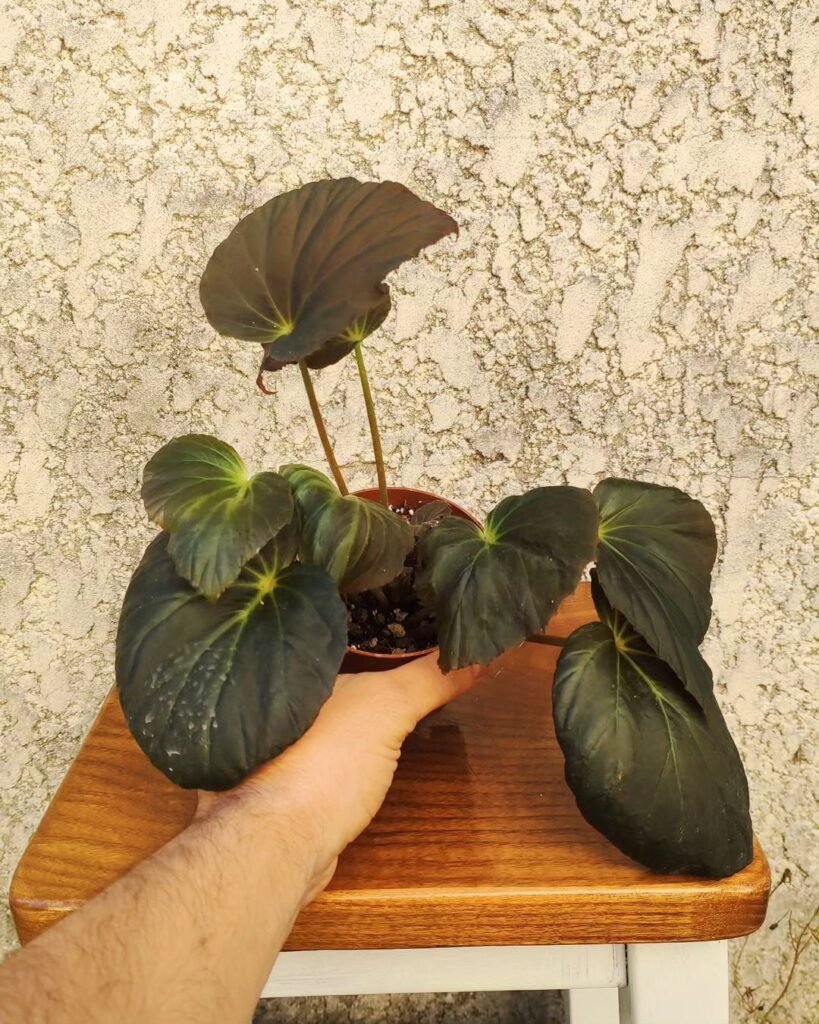
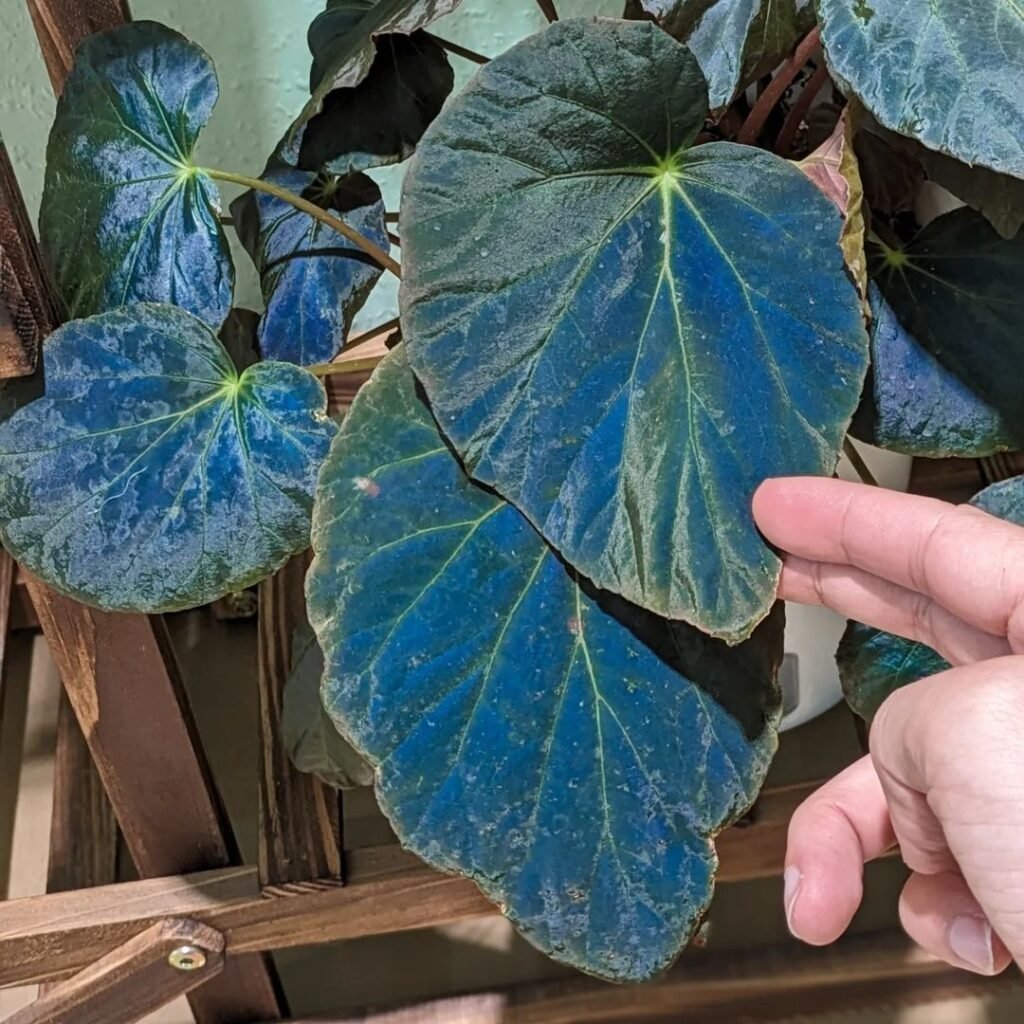

Genus Species
Begonia Pavonina belongs to the Begoniaceae family, which encompasses a wide range of begonia species. Within this family, Begonia Pavonina falls under the Begonia genus, which includes more than 1,800 species. The Begonia genus is known for its diverse range of plant forms, sizes, and features, making it an exciting and popular choice among plant collectors.
Subspecies and Varieties:
- Begonia Pavonina var. Major: This variety of Begonia Pavonina typically has larger leaves and is highly sought after by collectors for its grandeur.
- Begonia Pavonina var. Minor: In contrast, this variety is more petite in size and often displays more intense iridescence in its leaves.
- Begonia Pavonina ‘Green’: A variant that has predominantly green leaves with subtle iridescence.
Hybrids:
Begonia Pavonina is often used in hybridization, creating exciting variations that blend its unique characteristics with other begonia species.
Begonia Pavonina Appearance
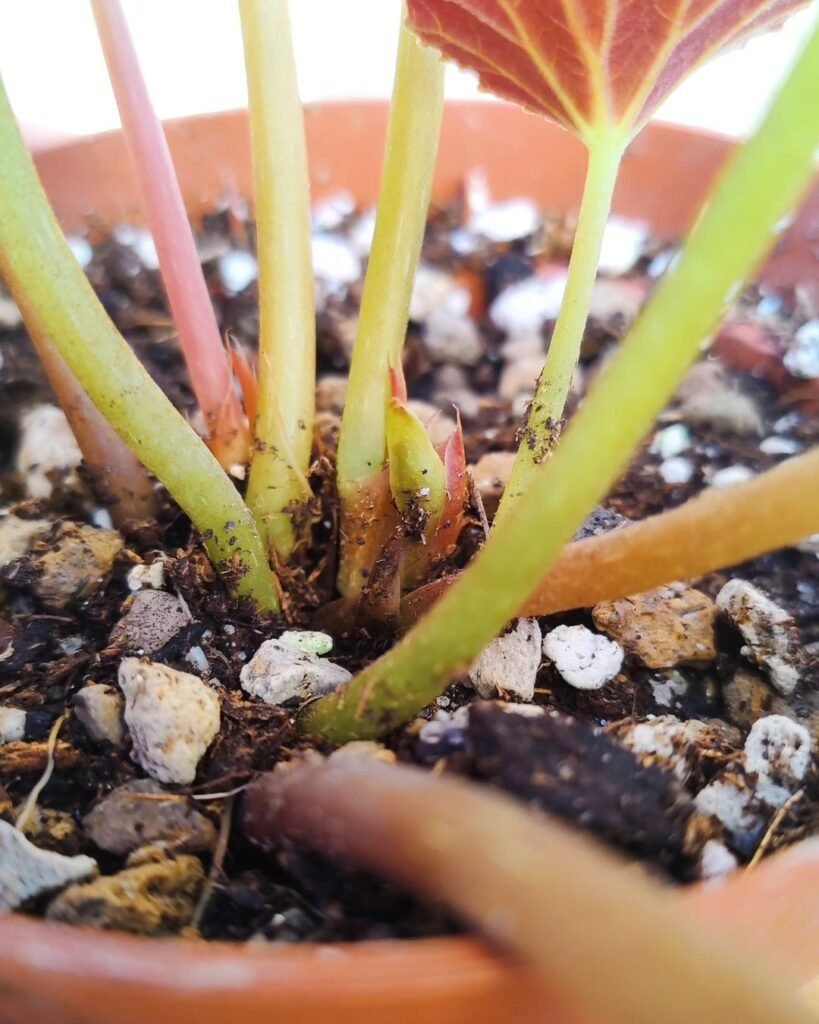
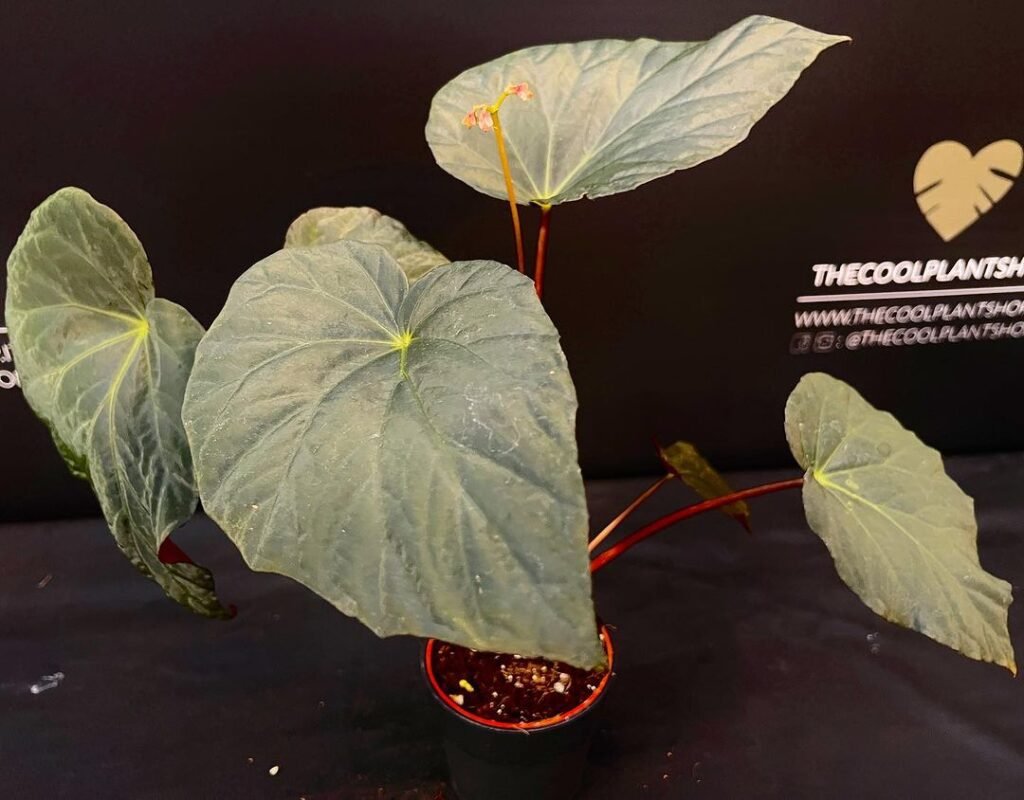
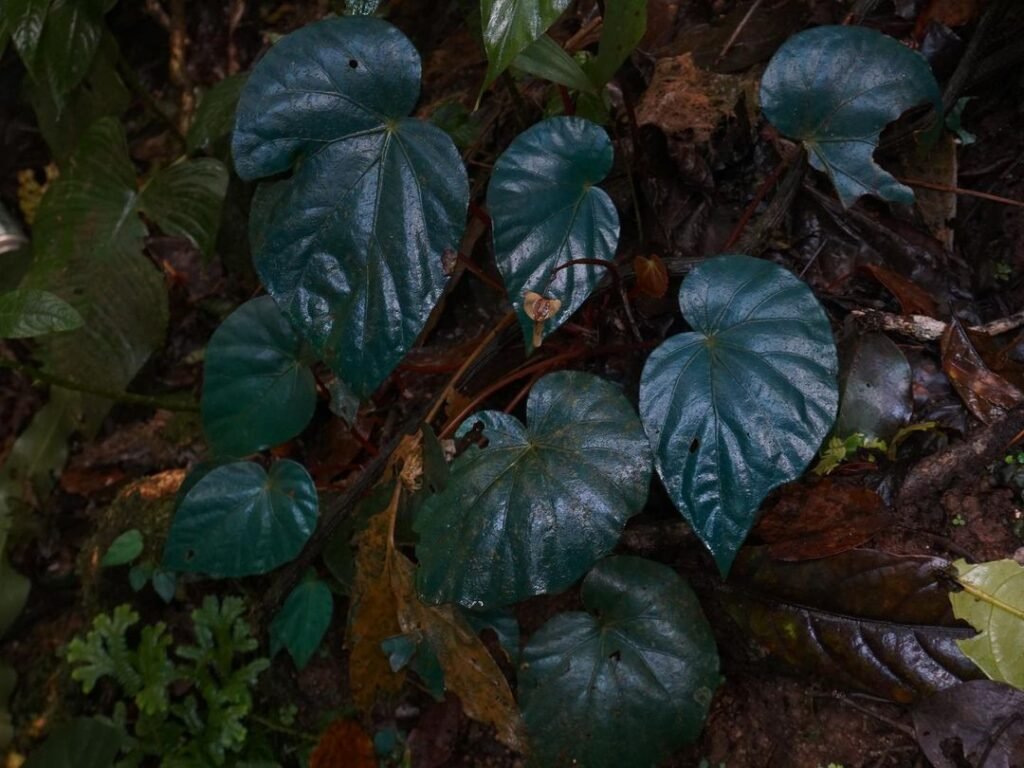
The allure of Begonia Pavonina lies in its striking appearance. Its foliage is the main attraction, and understanding its distinct features is essential for its care and maintenance.
Leaf Structure and Color:
- Iridescent Blue-Green Leaves: The most captivating aspect of Begonia Pavonina is its leaves, which are covered with tiny, iridescent scales that reflect light in shades of blue and green. This iridescence gives the leaves their peacock feather-like appearance.
- Rounded Shape: The leaves are typically rounded, with serrated edges, and they can grow to be around 2-3 inches in diameter.
- Undersides: The undersides of the leaves are often a rich red or burgundy color, adding to the plant’s visual intrigue.
- Stem and Growth Habit: Begonia Pavonina features a slender, creeping stem, and it tends to grow in tight clusters, creating a dense and lush appearance.
Notable Features:
- Flowering: While the leaves are the star of the show, Begonia Pavonina produces delicate pink flowers when it blooms, adding an extra touch of beauty to the plant.
- Seasonal Changes: The intensity of the iridescence may vary depending on the plant’s age and environmental factors, so don’t be surprised if your Begonia Pavonina’s appearance evolves over time.
Not the plant for you? Check out my full list of 78 Types of Begonia!
Begonia Pavonina Care Tips
Taking care of Begonia Pavonina requires a good understanding of its unique needs. This table provides a quick overview of the essential care tips and tricks for this exotic begonia:
| Care Aspect | Recommendations |
|---|---|
| Light | Indirect, bright, but not direct sunlight. |
| Temperature | Keep between 65-75°F (18-24°C) with minimal temperature fluctuations. |
| Humidity | High humidity (around 60-70%) is essential. |
| Soil | Well-draining, rich, and slightly acidic soil. |
| Watering | Keep soil consistently moist but not waterlogged. |
| Fertilization | Use a balanced, water-soluble fertilizer during the growing season. |
| Pruning and Shaping | Trim for shape and to remove dead or unhealthy growth. |
| Propagation | By stem cuttings or division. |
| Seasonal Care | Adjust care based on the seasons. |
| Pest Control | Inspect regularly and use natural remedies for pests. |
These care tips provide a solid foundation for nurturing your Begonia Pavonina and ensuring it thrives in your care.

Begonia Pavonina Light and Soil Requirements
Light Requirements
Begonia Pavonina’s unique iridescent leaves require specific lighting conditions to maintain their brilliance. Here’s what you need to know:
- Indirect Light: Provide bright, indirect sunlight, but avoid direct sun exposure. Too much sun can scorch the delicate leaves.
- Artificial Light: If natural light is limited, consider using fluorescent grow lights placed a few feet above the plant to ensure it receives adequate illumination.
Soil Requirements
A suitable growing medium is vital for the overall health and vibrancy of Begonia Pavonina:
- Well-Draining Soil: Use a well-draining potting mix to prevent waterlogged roots. A mix that contains peat moss, perlite, and compost works well.
- Slightly Acidic pH: Begonia Pavonina prefers slightly acidic soil with a pH range of 5.5 to 6.5. You can adjust the pH using appropriate soil amendments.
Watering Begonia Pavonina

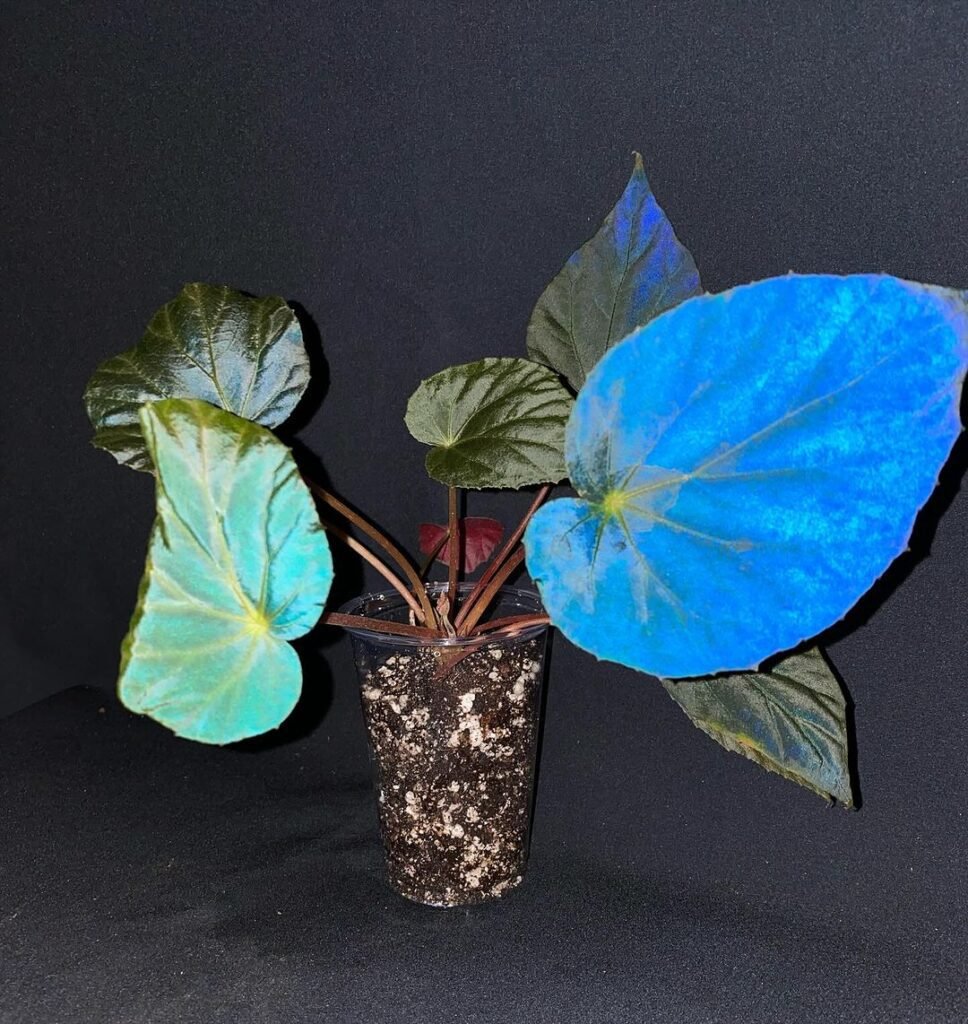
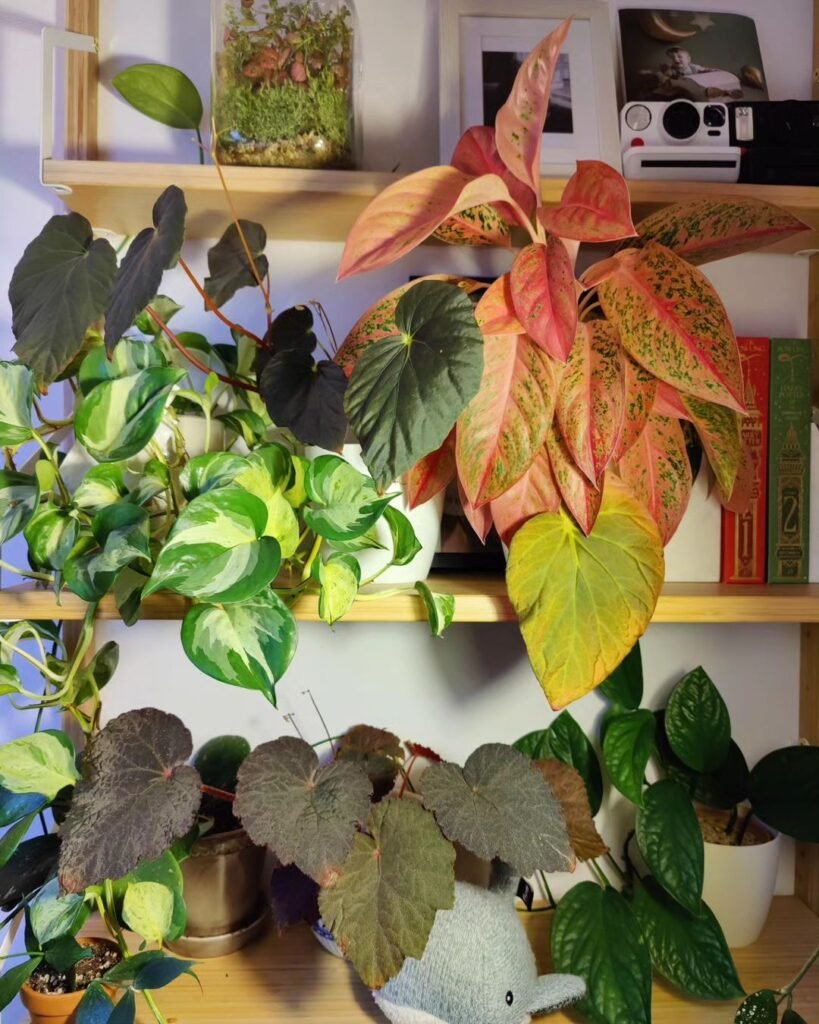
Proper watering is crucial for Begonia Pavonina, as it is sensitive to both overwatering and underwatering. Follow these guidelines to maintain optimal soil moisture:
- Consistent Moisture: Keep the soil consistently moist but not waterlogged. Avoid letting the soil dry out completely between waterings.
- Watering Technique: Water the plant thoroughly, allowing excess water to drain from the pot. Always empty the saucer under the pot to prevent standing water.
- Water Quality: Use room-temperature, filtered water to avoid shocking the plant with cold or chlorinated water.
- Seasonal Adjustments: Be mindful of seasonal changes; you may need to water more frequently during the active growing season and reduce watering during the plant’s dormant phase.
By adhering to these lighting, soil, and watering requirements, you can ensure your Begonia Pavonina remains healthy and continues to exhibit its captivating iridescence.
Begonia Pavonina Humidity and Temperature
Humidity Requirements
Maintaining the right levels of humidity is critical for the well-being of Begonia Pavonina:
- High Humidity: Begonia Pavonina thrives in a humid environment, ideally around 60-70%. If your indoor air is dry, consider using a humidifier or placing a tray of water and pebbles near the plant to increase humidity.
- Misting: Regularly misting the plant with distilled or filtered water can help keep the humidity level suitable for its needs. Ensure the leaves are lightly misted, as the iridescent scales are more effective when not obstructed by water droplets.
Temperature Tolerance
Begonia Pavonina has specific temperature preferences:
- Moderate Temperatures: Keep the temperature between 65-75°F (18-24°C) to mimic its native rainforest environment.
- Avoid Drastic Fluctuations: Try to maintain consistent temperatures. Avoid exposure to drafts, sudden temperature drops, or extremes, as Begonia Pavonina is sensitive to temperature fluctuations.

Fertilizing Begonia Pavonina
Proper fertilization is essential for promoting healthy growth and vibrant foliage in Begonia Pavonina:
- Balanced Fertilizer: During the growing season (spring and summer), use a balanced, water-soluble fertilizer with an NPK ratio of 20-20-20 or similar. This provides essential nutrients for growth.
- Frequency: Fertilize every 4-6 weeks to avoid over-fertilization. Reduce or stop fertilizing during the dormant period in winter.
- Dilution: Follow the manufacturer’s instructions for diluting the fertilizer. Under-fertilization is less harmful than over-fertilization, which can damage the plant.
| Fertilizer Type | NPK Ratio | Frequency | Dilution |
|---|---|---|---|
| Balanced Fertilizer | 20-20-20 or similar | Every 4-6 weeks | As directed on packaging |
By providing the right humidity levels and maintaining an appropriate temperature range, along with a well-balanced feeding schedule, you can ensure your Begonia Pavonina thrives and remains a spectacular addition to your plant collection.
Begonia Pavonina Pruning and Shaping
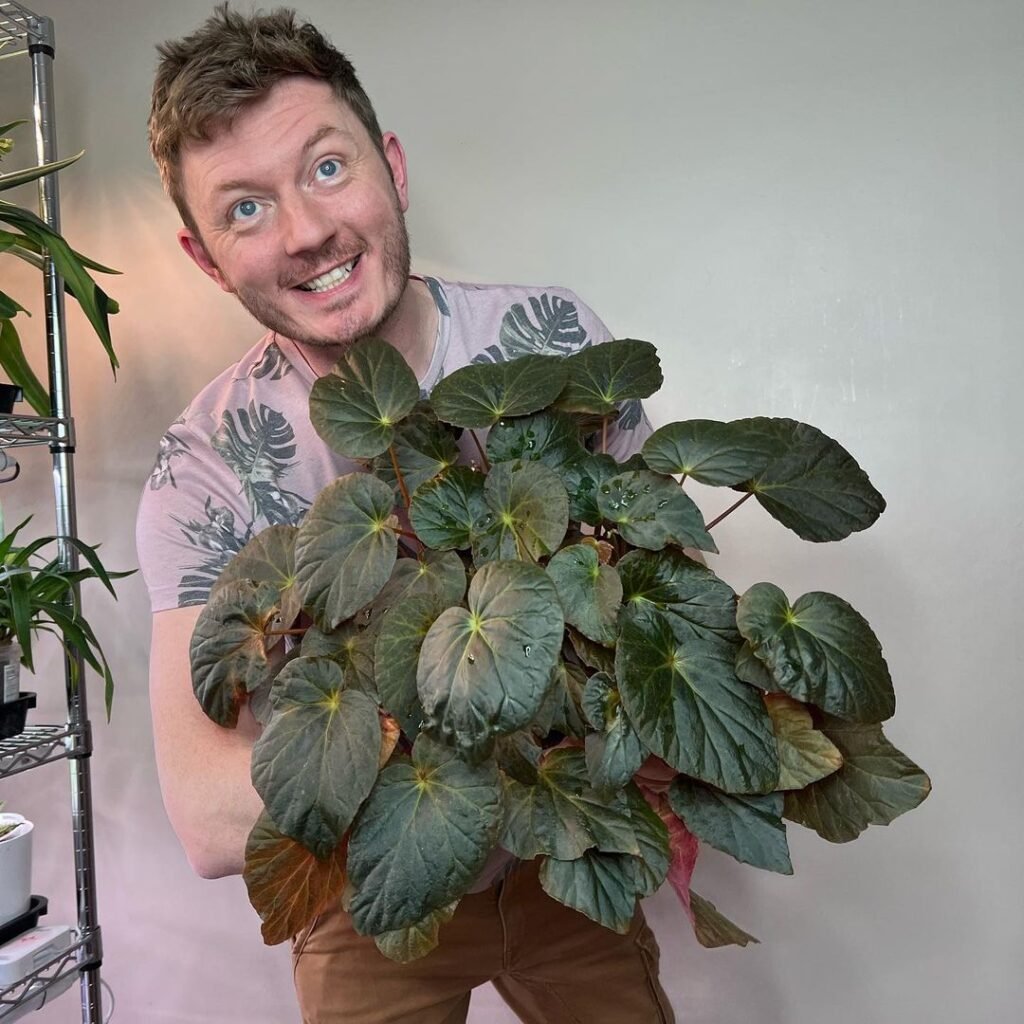
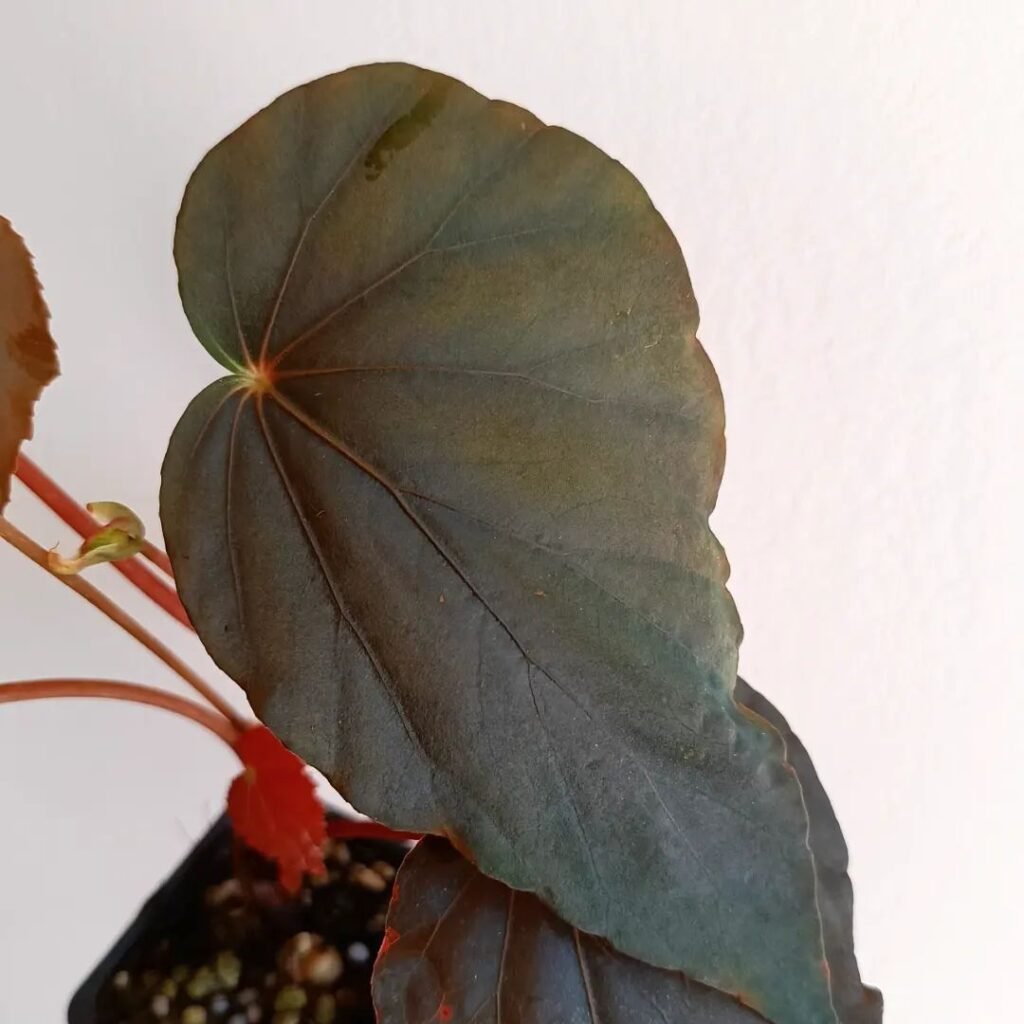

Pruning and shaping your Begonia Pavonina are essential for maintaining its appearance and overall health:
- Shape Maintenance: Prune for shape, ensuring a bushy and compact growth habit. Trim leggy or overly long stems to maintain an attractive appearance.
- Deadhead Flowers: Remove spent flowers to encourage additional blooming and prevent energy wastage.
- Remove Unhealthy Growth: Regularly inspect your plant for any damaged, yellowing, or diseased leaves. Prune these away to promote healthy growth.
- Stem Cuttings: Pruned stems can be used for propagation, giving you the opportunity to create new Begonia Pavonina plants or share them with fellow enthusiasts.
Keep in mind that Begonia Pavonina’s unique beauty lies in its foliage, so careful pruning and shaping will help showcase its iridescent leaves to their full potential.
Begonia Pavonina Propagation and Repotting
Propagation Methods
Begonia Pavonina can be propagated through stem cuttings or by dividing the rhizome:
- Stem Cuttings: To propagate from stem cuttings, follow these steps:
- Select a healthy stem with a few leaves.
- Cut the stem just below a leaf node.
- Place the cutting in a well-draining rooting medium.
- Keep the medium consistently moist, and roots should develop in a few weeks.
- Dividing the Rhizome: To propagate by division, follow these steps:
- Carefully remove the plant from its pot.
- Divide the rhizome into sections, making sure each section has roots and healthy growth.
- Replant the divided sections in separate pots with suitable potting mix.
Table: Propagation Methods
| Propagation Method | Best Time | Success Rate |
|---|---|---|
| Stem Cuttings | Spring | High |
| Dividing the Rhizome | Spring | High |
Repotting
- Repotting Frequency: Begonia Pavonina generally requires repotting every 1-2 years, typically in the spring when it’s actively growing.
- Reasons for Repotting: Repot to refresh the soil, provide more space for root growth, and encourage healthy development.
- Pot Size: Choose a pot that is slightly larger than the current one, ensuring it has drainage holes.
- Soil: Use a well-draining potting mix, as mentioned earlier.
Begonia Pavonina Seasonal Care
Begonia Pavonina’s care needs may vary with the changing seasons:
Spring and Summer
- Growth Season: These are the active growth months for Begonia Pavonina.
- Increase Fertilization: During this period, increase the frequency of fertilization to every 4-6 weeks with a balanced fertilizer.
- Regular Pruning: Maintain its shape by regularly pruning leggy growth and removing dead leaves.
- Keep Humidity High: Ensure high humidity levels, especially if the air tends to be drier in your location.
Fall and Winter
- Dormant Phase: Begonia Pavonina may go through a dormant phase during the cooler months.
- Reduce Watering: Decrease the frequency of watering, allowing the soil to dry out slightly between waterings.
- Limit Fertilization: Reduce or entirely stop fertilization during the dormant period.
- Watch for Pests: Be vigilant for pests, as indoor plants are more susceptible during this time.
Adapting your care routine to the changing seasons is crucial for maintaining the health and vitality of your Begonia Pavonina.
Begonia Pavonina Companion Plants
Pairing Begonia Pavonina with suitable companion plants can enhance the aesthetic appeal of your indoor garden. Here are some great options:
- Ferns: The lush, feathery fronds of ferns complement the iridescent foliage of Begonia Pavonina beautifully.
- Calathea: Calathea plants share similar humidity requirements and offer striking foliage patterns, making them an excellent match.
- Peperomia: Peperomia plants come in various leaf shapes and colors, adding diversity and texture to your plant display.
- Ivies: Ivies are versatile and come in numerous varieties, making them ideal for creating cascading effects in your garden.
- Fittonia: Fittonia plants, with their vibrant veined leaves, provide a lively contrast to Begonia Pavonina.
When selecting companion plants, consider their care requirements, as well as their visual harmony with Begonia Pavonina, to create a stunning and harmonious indoor garden.
Common Pests
- Aphids: Small, soft-bodied insects that can cluster on the underside of leaves and feed on plant juices.
- Mealybugs: Tiny, white, cotton-like insects that hide in leaf crevices and feed on sap.
- Spider Mites: Microscopic arachnids that spin fine webs and feed on plant juices, causing stippling and webbing.
- Scale Insects: Hard or soft scale insects attach themselves to stems and leaves, feeding on plant sap and producing a sticky substance called honeydew.
Reviving a Sick or Wilting Begonia Pavonina
If your Begonia Pavonina shows signs of wilting or poor health, there are steps you can take to nurse it back to vitality:
- Assess the Issue: First, identify the problem. Check for overwatering, underwatering, pests, or diseases.
- Adjust Watering: Adjust your watering routine based on the plant’s needs. If the soil is waterlogged, allow it to dry out; if it’s too dry, increase watering.
- Trim and Prune: Remove any damaged or unhealthy leaves and stems to encourage new growth.
- Inspect for Pests: Thoroughly inspect the plant for pests, and if found, treat as necessary with appropriate remedies.
- Repotting: If your plant has outgrown its pot, consider repotting it with fresh soil and a slightly larger container.
- Provide Ideal Conditions: Ensure the plant is placed in optimal lighting, temperature, and humidity conditions.
With attentive care and addressing the underlying issues, your Begonia Pavonina can recover and flourish once again.
Love all types of Begonia? Make sure to catch up on my post on how to care and grow for begonia brevirimosa. After you’ve finished reading that, why not also check out my care guide on how to grow watermelon begonia.
Conclusion
Begonia Pavonina, the enchanting Peacock Begonia, is a remarkable addition to any plant enthusiast’s collection. Its iridescent foliage and relatively easy care requirements make it an excellent choice for both novice and experienced gardeners. By providing the right environment, proper watering, and regular maintenance, you can enjoy the beauty of Begonia Pavonina in your indoor or outdoor garden.
Remember to adjust your care routine according to the changing seasons and be proactive in pest control to ensure the longevity and vibrancy of your plant.
FAQs
How often should I water my Begonia Pavonina?
Begonia Pavonina prefers consistently moist soil. Water it when the top inch of the soil feels dry, but avoid overwatering, which can lead to root rot.
Can Begonia Pavonina tolerate direct sunlight?
No, Begonia Pavonina is sensitive to direct sunlight. It thrives in bright, indirect light but should be shielded from harsh sun rays.
What is the best soil mix for Begonia Pavonina?
A well-draining potting mix that includes components like peat moss, perlite, and compost works well. The soil should be slightly acidic with a pH between 5.5 and 6.5.
How can I propagate Begonia Pavonina?
Begonia Pavonina can be propagated through stem cuttings or by dividing the rhizome. Spring is the best time for propagation.

Writer/Green Thumb/Explorer – Rooted deep in the rich soils of Devon, I’ve cultivated a vast expertise in plant care, helping greenery thrive in homes across the UK. When I’m not crafting detailed plant care guides, I’m journeying through the lush landscapes of the West Country, unearthing nature’s secrets and sharing them with fellow plant enthusiasts. Every leaf has a story, and I’m here to tell it.





